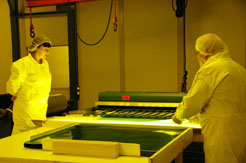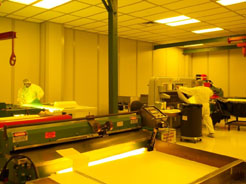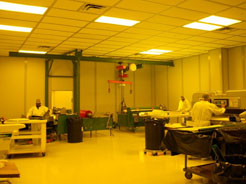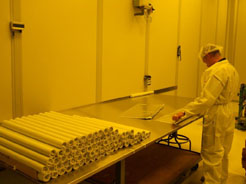
With its manufacturing and corporate headquarters based in Brooklyn, New
York, the Ulano Corporation
is recognized as a world-class leader in the
screen printing and graphics arts industry.
Introducing Ulano
Ulano specializes in the manufacture of stencil-making products and chemicals for screen process printing. We also supply masking films, inkjet media, automated coating equipment, exposure test positives, and stencil evaluation tools. Our administrative and manufacturing headquarters is in Brooklyn, New York, where we also have research and development laboratories, applications laboratories, and a technical training center. Ulano has an international representative office and training center in Schlieren /Zurich, Switzerland, an Asian regional office in Singapore, and a branch office in Shanghai, China.
The founder of the company, Joseph Ulano, was a Russian immigrant to New York. In the 1920s, he found work in the screen printing industry and set about to make improvements, especially in stencil making. In 1929, just before the Great Depression, Joe Ulano invented the film stencil. He formed a film coating company in 1931. Over the years, Ulano has grown from a small company into the world’s largest completely integrated manufacturer of screen printing stencil systems.
Ulano’s more than 75 years of growth have always been technologically driven. We have a proud history of innovation. In addition to the film stencil, Ulano. . .
- Invented masking films (under the Rubylith® and Amberlith® brand
names).
- Formulated the first reclaimable, 100% solvent and water resistant
emulsions.
- Developed the first fast-exposing diazo resins.
- Was the first manufacturer
to eliminate bichromates and, later, di-butyl phthalate from all our
photographic products.
- Introduced capillary film
to the world market.
- Manufactures the widest range of indirect system
photographic films in the industry.
- Offered the first comprehensive,
industry-specific line of screen chemicals.
Ulano’s new product introductions continue, and include EZ-FILM textile capillary film, new screen chemicals, Pulsar no-developer stencil film, QLT ultra-fast SBQ textile emulsion, QT-DISCHARGE emulsion for water-based and discharge inks, and Quasar R 100, a red indirect system photographic film.
In 1999, Ulano was acquired by a German-Swiss holding company that also owns Kissel + Wolf GmbH (KIWO), a manufacturer of screen printing consumables, adhesives, automatic coating machines, and computer-to-screen equipment. The Kissel + Wolf GmbH Group have offices and manufacturing facilities in Germany, Texas, Singapore, Australia, and India. The new owners have made important investments in Ulano’s facilities and staff, reinforcing the company’s traditional strengths in innovation, technical education, technical service, and market leadership, domestically and internationally.
As before, Ulano’s future growth will be based on technological innovation, but by careful, logical extensions of research and development skills and manufacturing capabilities, rather than by dramatic leaps into unfamiliar territory. In this way, we will protect and strengthen the Ulano brand name, one of the best known in the entire graphic arts industry.
Ulano will continue to utilize our domestic and international channels of distribution, nurtured for over two generations, to promote the Ulano brand. As an inter-national company, we must meet the environmental, technical, manufacturing, and commercial demands of worldwide competitiveness. We embrace these challenges and are strengthened by them!
Film Conversion Clean Room
We’re proud to share with you photographs of our new Film Conversion Clean Room and its crew. The new facility, which is located in our main factory and lab complex, supersedes a filtered air, positive vacuum conversion facility that had been located in a separate building about 1 ½ miles (≈ 2 ½ km.) distant. For years, master film rolls coated in our factory had been transported to the conversion facility, then returned, as finished rolls or sheets, to the factory complex where our warehouse is also located.
By placing the new Film Conversion Clean Room literally a few meters from the coating machines, we have been able to minimize the handling of work-in-progress master film rolls and reduce intra-city transportation. Our objective is to produce film products that meet the needs of our most demanding and technically sophisticated customers. We want Ulano film products to continue to be the first choice of industrial producers of printing for PCB work, flexible circuitry, RFID devices, solar panels, membrane and touch panels, ceramic decals, etc. Our new Film Conversion Clean Room is the newest marker of our commitment to continual improvement of product quality and manufacturing efficiency.
We continually try to find ways to improve our in-process quality monitoring to insure that each intermediate production step meets specific tolerances before continuing on to the next step. In addition, in recent years we have placed increased reliance for monitoring quality in the hands of our production managers and operators—our Film Conversion Clean Room Crew among them. They take pride in their work. Moreover, they are closest to the production processes and, during their many years of production experience, have developed a “sixth sense” for quality. Their empowerment results in more rapid correction of any in-process deviations.




Leading in Light Sensitive Technology
Direct emulsions have been used for screen-printing for nearly 50 years and
have become increasingly sophisticated
because of advancements in the chemical
industry, especially polymer chemistry and
light-sensitive systems.
What started as bichromate-sensitised,
water-based adhesives (glues) and gelatinbased
indirect system stencil films, have
evolved into specialised, high performance,
coatings that are used in the screen-printing
of LCD screens, flexible circuits, solar panels
and other high precision manufactured
items.
In the mid 1960s, Ulano released
indirect system, gelatin-based films that did
not require bichromate sensitisation. They
were ‘presensitised,’ utilising iron salts and
requiring an oxidation-reduction developing
step using hydrogen peroxide. In the mid
1970s, led by Ulano, environmentally conscious
companies replaced bichromates
(discovered to be carcinogenic) in direct
emulsions with the light-sensitive dye that
became known in the industry as diazo. Far
safer to handle than bichromates, diazo
offered the additional advantages of extended
storage, pot and shelf life, and in some cases
greater exposure latitude.
With the introduction of diazo, emulsions
become more specialised, with two distinct
categories becoming available – those that
had high water resistance and those that had
high solvent resistance. Two Ulano products
became staples of the industry – 569 offered
total solvent resistance and reclaimability
while TZ (later superseded by 925WR)
became a work-horse product for printing
water-based inks, and was also reclaimable.
BREAKTHROUGHS IN THE EIGHTIES
The 1980s saw two major breakthroughs in
emulsion technology. The first was
associated with development of stilbazolium
quartenary (SBQ) salt, an innovative, very
efficient sensitiser for use with direct
emulsion polymers. SBQ provided extremely
fast exposure times, allowing the successful
utilisation of low intensity, non-industryspecific
light sources by smaller shops, and
the increasing use of projection cameras for
large format graphics. SBQ-based pre-sensitised emulsions
lacked water resistance and offered limited
solvent resistance as well. Nevertheless, SBQ
quickly became the stencil technology for
plastisol printing. Ulano’s QTX consequently
become the product of choice for many
textile printers worldwide.
Ulano continues to develop emulsions in this category, further enhancing
the performance
of SBQ-based emulsions. CTS-FAST was
introduced in early 2010. Like QTX, CTS-FAST
became a product of choice for scanning, low
intensity computer-to-screen light sources.
Innovative anti-halation technology,
developed at Ulano, brought further advantages
to the SBQ-based product category; with
ORANGE textile emulsion becoming Ulano’s
best-selling product within two years of its
introduction in 2012.
The second break-through in the eighties
came with the commercial availability of lightsensitive
acrylic resins.
The incorporation of acrylates allowed the
creation of so called ‘dual-cure’ emulsions, in
which the acrylate resin phase of the emulsion
is already pre-sensitised. Added at the point of
use, diazo is still responsible for sensitising the
water-soluble phase of the emulsion. Dual-cure,
or diazo-photopolymer, emulsion technology
allowed the development of more universal,
higher resolving, more durable, better imaging
products that often afford equal resistance to
water-based and solvent-based inks.
RLX was one of Ulano’s first dual-cure
products and within three years of introduction,
its production reached 182 metric tons (400,000
pounds) a year. Subsequently, more specialised
Ulano dual-cures – high solvent resistance
Proclaim and LX-660 with its matte surface and
high humidity resistance – became well-known
and commercially successful products.
NO HARDENER REQUIRED
The newest product at Ulano in this category
is Double-Duty emulsion. The exceptional
water resistance of this emulsion allows it to
be used without a hardener, yet it offers
excellent reclaiming properties, along with
good resistance to water-based and discharge
inks. It also has superb mechanical durability
and resists very acidic media.
For a decade, the choice still had to be
made between limited resistance, fast SBQbased
products, or the better copying, more
versatile dual-cure products that required
sensitising at the point of use.
SBQ-DUAL CURES:
HYBRID EMULSION
The next breakthrough in the labs came in the
late 1990s and early 2000s when advances
by Ulano R&D made it possible to combine
both SBQ and dual-cure photochemistry in ‘hybrid’ technology, introduced by Ulano in its
QX-1 emulsion. Hybrid emulsions are dualcure
emulsions that use SBQ instead of diazo.
The longer pot life of SBQ allows the hybrids
to be pre-mixed; they are pre-sensitised and
ready-to-use.
The introduction of hybrid technologies
alleviated many of the limitations of SBQ
technology. Though slower to expose than
SBQs, hybrids offer solvent resistance suitable
for the graphic arts market. Exposure speed
still remains fairly fast, so that hybrid
Being introduced by Ulano is its DP-800 stencil
emulsions can be used in textile printing shops
with low-intensity light sources or the need for
rapid stencil throughput.
Hybrid emulsions at Ulano have
proliferated over the years, now including the
very versatile QX-5 series, which has an
excellent track record with new UV-LED light
scanning units.
The newly introduced fast-exposing
Platinum emulsion for the textile market offers
very short exposure (generally not characteristic
of the hybrids), with the excellent durability of
hybrids, and also features easy decoating.
A NEW PRODUCT SERIES:
EC-CURE EMULSION.
Two years ago advancements in the photochemical
technology of presensitising emulsion
allowed Ulano to ntroduce another group of
screen-printing products – the ‘EC’ or EPICCure
emulsions. These EPIC-Cure emulsions,
utilising RD-sensitising technology, resemble
dual-cure performance, with solvent and
humidity resistance comparable to that of
universal dual-cures. EC products, which are
presensitised, do not require sensitising at the
point of use and offer most of the favourable
properties of dual-cure emulsions.
EPIC-Cure (EC) emulsions have a light
sensitivity similar to SBQ-sensitised products;
however, their response to light is much more
precisely controlled, facilitating much better
cross-linking density, copying, and resistance
properties than those normally associated with
SBQ-sensitised emulsions. Ulano has
introduced to the market the first product of
this series, Proclaim-EC, and is in the process
of introducing another (now called DP-800).
Ulano has received very positive responses
from the first users of EC products,
commenting on how easy the process is for the
stencil maker by eliminating sensitising and
degassing time, and simplifying the product
and process for the stencil maker. Moreover,
with EC-technology, the usual problems of SBQ
sensitised products – often fuzzy edges due to
their very small exposure window, lower crosslinking
density and associated limited
resistance – are gone as well. RD-sensitising
technology has, once again, allowed Ulano to
create easier-to-use and better performing
products.
Mission Statement
Our primary objective is to offer outstanding service to our customers!
This will be accomplished by:
•
Understanding and exceeding customers’ needs and expectations.
• Striving for 100% satisfaction.
•
Delivering on-time, technologically suitable and beneficial products
of the highest quality standards in our industry.
• Maintaining a friendly and courteous attitude.
• Uncompromising integrity.
• Training our customers on how best to use our products
and understand the benefits that they offer.
• Making every effort to assist in finding solutions to challenges.